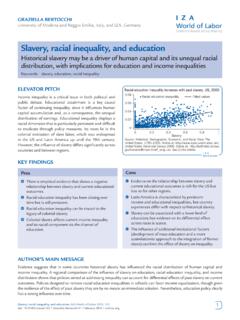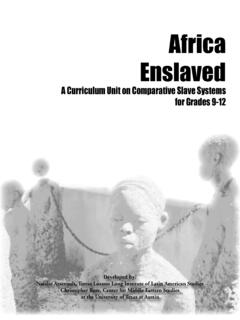Transcription of Childhood Slavery in North America - The National Archives
1 What Was it Like to be a Child Slave in America in the Nineteenth Century? Most slave societies which resulted from the transatlantic slave trade depended on the constant importation of native Africans to replenish the population. In contrast in the United States the slave population quickly began to sustain itself through natural reproduction. It is estimated that by the time of the official end of the transatlantic slave trade in the USA in 1808 less than 1 million Slaves had been imported into the country and after 1807 the majority of illicit trading in slaves was of children. By 1860 the population had increased to 3,952,760 56% of which were under the age 0f 20 (1) This Statistic gives an indication of the large numbers of slaves who experienced their Childhood within the system that existed within the United States.
2 Willie Lee Rose(2) summed up the situation about research into this topic The disturbing truth is that we know less than we ought to know about Childhood in Slavery despite the significance psychologists attribute to experiences of infancy and youth in development of personality The Intention of this investigation is to look in detail at the day to day life of slave children including work, leisure time and general living conditions The child slaves were viewed by their masters as and society in general as valuable assets with a monetary value of their own and an investment for the future . it would seem obvious that such assets would be protected and nurtured if only for economic reasons.
3 However in reality the living standards experienced were determined by the benevolence of the masters and the resourcefulness of slave parents. No two experiences are identical and narratives differ accordingly, some claiming they worked continuously throughout their formative years and others that play was an essential part of their lives. By necessity the whole slave community needed to take responsibility for the rearing of slave children. Mothers were as a rule expected to return to work and babies were looked after by the very old and the very young. There was invariably a large number of children to look after over very long hours. Francis Fredric (3) described feeding of the children on his plantation.
4 Children fed like pigs out of a troughs and being supplied sparingly, invariably fight and quarrel with one another over their meals The food provided was often termed pot liker which is often described as a vegetable based broth. Steckel (4) describes the lack of protein in the children s diets and suggests that as a result malnutrition ensued described by one slave owner Shiny bodies, plump bellies and glistening ribs . This can be seen as typical presentation of malnourishment. Conversely another slave in his narrative described an altogether different situation us have plenty of good food to eat too. Beef and hawgs and bacon and syrup and sugar and flour was plenty.
5 All de possums and rabbits and fish and such wer jus dat much more (5) Clothing for slave children was in general very basic and generally consisted of a smock like garment worn by both boys and girls. The clothing of child slaves who in general produced very little was rarely a priority and it appears not to have been a unusual sight to see naked children on a plantation. Lost and torn clothing was rarely replaced and the growing patterns of children were not taken into account. Once they took up field work boys would often have been provided with trousers and a shirt, whilst girls were given a dress. Shoes were not common and any footwear would have tended to be of a homemade moccasin type.
6 Children who worked in the big house would have tended to have been better dressed. King(6) describes the situation Slaveholders were more concerned about the cost of slaves clothes and shoes than about their comfort Visitors to southern plantations described ,huts, hovels, and houses, with an occasional narrative romanticizing them as quarters at Gowrie measured 18 by 18 feet and were built side by side, with a fire place in the centre that served both quarters. Each side was occupied by at least four people. (7) An ex- slave described the lack of furniture in his home: Us never had a chair in the house. My Pa made benches for us to site by the fire had a large plank table that Pa made.
7 Never had no mirrors. Went to spring to see ourselves on a Sunday morning. Never had no such things as dressers in them days. All us had was a table, benches, and beds. And my Pa made them (7) The housing conditions of slaves again depended on the beneficence of the owner and the resourcefulness of the parents. Child slaves would not automatically live in a traditional family. Limited,cramped conditions and the lack of recognition of slave marriage and family links by the owners often led to children being placed with adults other than their parents The work of slave children is of particular relevance in that this is the fundamental reason for their enslavement. Ages at which slaves were put to work varied enormously between plantations, but the pattern appears to have been that most owners favoured a gradual introduction to labour.
8 Rawick(8) describes the situation by stating that some toddlers were working in the fields alongside their mothers whilst the oldest age found for the start of work was 21. Only 48% of interviewees in the Slave Narrative Collection describe doing any form of work before the age of 7 (9) Tasks performed by younger children do not appear to have been gender specific and include taking water to the fields, tending animals and gardens, kitchen and housework and nursing younger children. Some boys were also given the opportunity to learn trades such as blacksmith or carpentry which would have begun at an early age. Play would appear to be an anomaly in the world of Slavery . As an important psychological activity it helped slave children in socialization and in the acceptance of distressing situations through role play games such as slave auction recreations.
9 Denied the luxury of formal shop bought toys, slave children improvised making houses out of tree and woodland materials, riding stick horses, and dolls out of rags, wood and string. Some games seem to have been common themes amongst the child slave population, although there appears to have been gender differences. Boys were more likely to play more physical games with the girls playing more with simply made dolls and wooden toys. A common game mentioned in numerous narratives is Hide the Switch a child would hide a simple switch cut from a tree and whoever found it would then chase the others in attempt to whip them. Perhaps this can be viewed as an attempt to deal psychologically with the constant fear of the lash and the authority of the Master.
10 Marbles also appears to have been popular in the latter days of Slavery especially amongst boys Lindsey Moore (10) details a marbles tournament his master took him to where he competed against slave children from other plantations. It appears to have been common for white children to play with their salve peers especially at an early age, this sharing of play appears to have dwindled by the age of 6-8 when the white children went to school Education for slave children was illegal in many states , and the vast majority of slave therefore remained illiterate. Out of 3,428 slaves interviewed by the WPA only 179 stated that they had learnt to read as slaves. For those slaves who did learn to read the common age seems to have been six and eight.

















